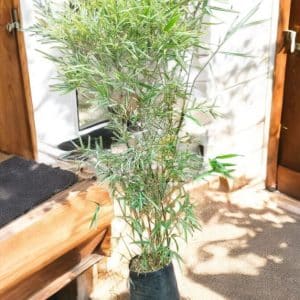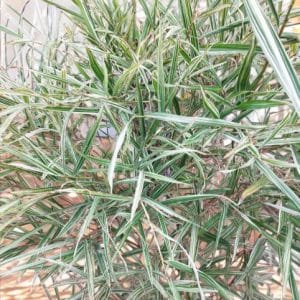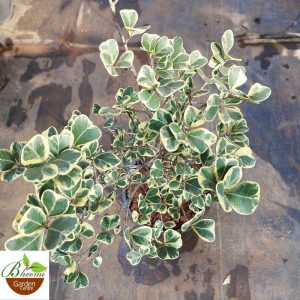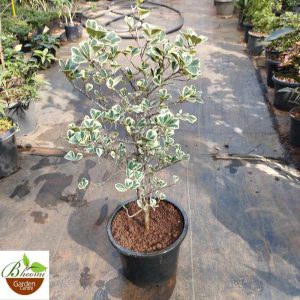Allamanda Blanchetii, Purple Allamanda or Violet Allamanda
This product is available for shipping only in Bangalore
Allamanda blanchetii (Purple Allamanda) is an evergreen climber boasting purplish pink to violet trumpet flowers and glossy green leaves. Flowering all year round, Purple Allamanda attracts biodiversity such as sunbirds for nectar in the 5-petalled flowers and is an attractive specimen, perfect for trellis and pergolas in parks and gardens.
Plant Height: approx 27 inches including the pot
Pot size : 9 inches nursery pot
- Estimated Delivery : Up to 3 business days
- Free Shipping & Returns : On all orders over ₹550 in Bangalore
Allamanda blanchetii, commonly known as Purple Allamanda or Violet Allamanda, is a beautiful flowering plant that belongs to the Apocynaceae family. Native to Brazil, this plant is valued for its lush, green foliage and striking purple to violet trumpet-shaped flowers. It can be grown as a shrub or a climbing vine, making it a versatile addition to gardens. Here’s a comprehensive guide to caring for Allamanda blanchetii:
1. Light Requirements
- Full Sun: Allamanda blanchetii thrives in full sun, which encourages optimal flowering. It needs at least 6-8 hours of direct sunlight daily.
- Partial Shade: While it prefers full sun, this plant can tolerate partial shade. However, too much shade may reduce the number of blooms.
2. Watering
- Regular Watering: Water the plant regularly to keep the soil consistently moist, especially during the growing season (spring and summer). It prefers moist but well-drained soil.
- Deep Watering: Water deeply and thoroughly to ensure that water reaches the root zone. Let the top inch of soil dry out slightly between waterings.
- Reduce Watering in Winter: During the dormant season (fall and winter), reduce the frequency of watering but do not let the soil dry out completely.
3. Soil
- Well-Draining Soil: Use rich, well-draining soil to prevent waterlogging and root rot. A mixture of garden soil, sand, and organic matter like compost works well.
- Slightly Acidic to Neutral pH: A soil pH range of 6.0 to 7.5 is ideal for Allamanda blanchetii.
4. Temperature and Humidity
- Warm Temperatures: Allamanda blanchetii prefers warm climates with temperatures ranging from 65-85°F (18-29°C). It is not frost-tolerant, so it must be protected from cold temperatures.
- Tropical Conditions: This plant thrives in high humidity, making it perfect for tropical and subtropical regions. If grown indoors, maintain humidity by misting the plant or using a humidifier.
5. Fertilizing
- Regular Feeding: Fertilize with a balanced, water-soluble fertilizer every 4-6 weeks during the growing season to encourage vigorous growth and abundant flowering.
- Organic Alternatives: Use compost or well-rotted manure as an organic option to enrich the soil.
6. Pruning and Maintenance
- Prune Regularly: Prune Allamanda blanchetii in early spring to control its size and shape, and encourage bushier growth. Trim back leggy or overgrown stems and remove any dead or damaged branches.
- Training: If growing as a vine, provide support such as a trellis, fence, or arbor for the plant to climb. Regularly train the vine to keep it neat and manageable.
7. Propagation
- Stem Cuttings: Allamanda blanchetii can be easily propagated through stem cuttings. Take 4-6 inch cuttings from healthy, non-flowering stems. Remove the lower leaves, dip the cut end in rooting hormone, and plant it in a potting mix. Keep the soil moist and the cutting in a warm, humid environment until roots develop.
- Layering: Another propagation method is layering, where a low-growing stem is bent down and partially buried in soil until it roots.
8. Pests and Diseases
- Common Pests: Watch for aphids, spider mites, and whiteflies, which can occasionally infest Allamanda blanchetii. Inspect the plant regularly and treat infestations with insecticidal soap or neem oil.
- Fungal Issues: The plant can be prone to fungal diseases such as powdery mildew and root rot if overwatered or kept in poor air circulation. Ensure good air circulation around the plant and avoid overhead watering.
9. Flowering
- Bloom Season: Allamanda blanchetii typically blooms from spring through fall, producing clusters of large, trumpet-shaped flowers in shades of purple to violet.
- Encouraging Blooms: Regular feeding, full sun, and proper pruning will encourage more flowers and healthy growth.
10. Toxicity
- Toxic to Pets and Humans: Allamanda blanchetii is toxic if ingested. It can cause stomach upset, vomiting, and diarrhea. The sap may also cause skin irritation. Keep the plant out of reach of pets and children, and handle it with care.
11. Container Growing
- Pot Requirements: If growing Allamanda blanchetii in a container, choose a large pot with drainage holes. Use a high-quality, well-draining potting mix.
- Repotting: Repot every 1-2 years or when the plant becomes root-bound. Refresh the potting mix and choose a slightly larger pot.
By following these care tips, your Allamanda blanchetii will thrive, providing a beautiful display of vibrant flowers that can enhance any garden, patio, or indoor space. Its striking purple blooms and lush foliage make it a favorite among gardeners looking to add a tropical touch to their landscape
** Plants photos are for representation purpose only. We will make best efforts to send the plants as in photos itself, however it is not always guaranteed as plants might overgrow or shrink depending on the season, care or age. Trust us, we want to give you the best.














Reviews
There are no reviews yet.